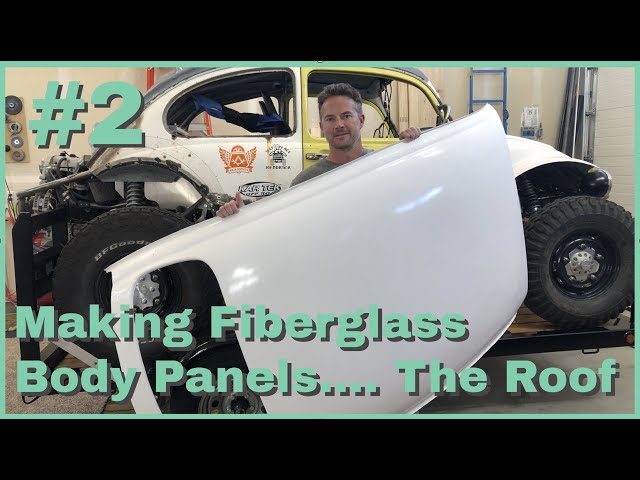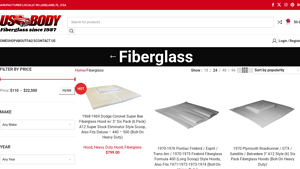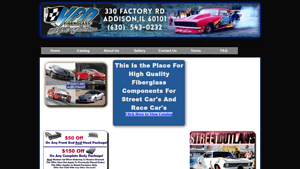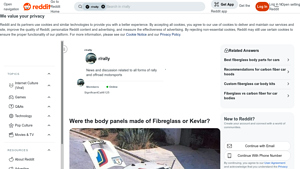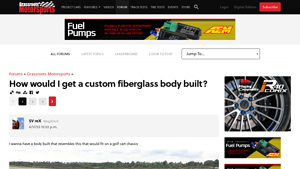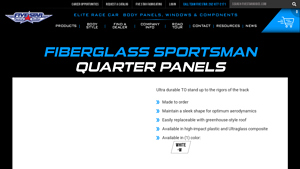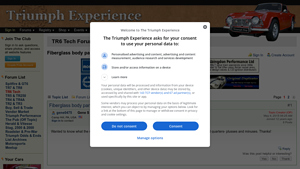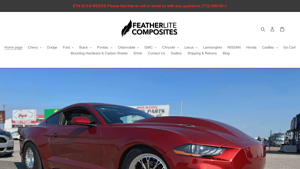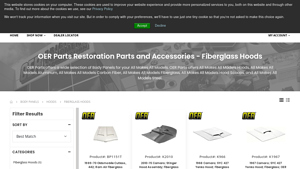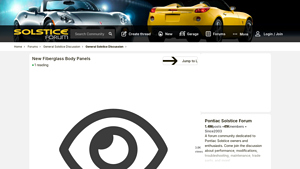Fiberglass Body Panels Guide: Type, Cost, Top List…
Introduction: Navigating the Global Market for fiberglass body panels
Navigating the global market for fiberglass body panels presents a unique set of challenges for international B2B buyers, particularly when it comes to sourcing high-quality components that meet specific design and performance standards. As industries across Africa, South America, the Middle East, and Europe increasingly turn to fiberglass solutions for their durability and lightweight properties, understanding the nuances of this market is essential. This comprehensive guide delves into the various types of fiberglass body panels, their applications across sectors such as automotive and marine, and critical considerations for supplier vetting.
By exploring key factors such as manufacturing processes, material specifications, and regional compliance standards, this guide empowers B2B buyers to make informed purchasing decisions. It addresses common pain points, including cost analysis and logistics, ensuring that buyers can navigate the complexities of international sourcing. Whether you are in Brazil seeking durable components for the automotive industry or in Nigeria looking for lightweight solutions for transport vehicles, this guide serves as a vital resource.
Ultimately, our goal is to equip you with the knowledge needed to confidently select suppliers who can deliver quality fiberglass body panels tailored to your specific needs, fostering successful partnerships that drive business growth in a competitive global marketplace.
Understanding fiberglass body panels Types and Variations
| Type Name | Key Distinguishing Features | Primary B2B Applications | Brief Pros & Cons for Buyers |
|---|---|---|---|
| Hoods | Lightweight, various styles (cowl induction, racing) | Automotive manufacturing, racing | Pros: Reduces weight, enhances performance. Cons: Can be more fragile than metal. |
| Bumpers | Impact-resistant, customizable designs | Automotive, aftermarket parts | Pros: Lightweight, can improve aerodynamics. Cons: Repair may be complex if damaged. |
| Quarter Panels | Designed for specific models, often bulged for aesthetics | Restoration, custom builds | Pros: Enhances vehicle appearance. Cons: Requires precise fitting. |
| Trunk Lids | Lightweight, often designed for performance applications | Racing, custom car builds | Pros: Reduces overall vehicle weight. Cons: Vulnerable to UV degradation over time. |
| Full Body Kits | Complete sets for extensive modifications | Custom builds, racing | Pros: Comprehensive aesthetic upgrade. Cons: High initial investment; requires skilled installation. |
What are the Characteristics of Fiberglass Hoods for B2B Buyers?
Fiberglass hoods are among the most popular types of fiberglass body panels due to their lightweight nature and performance-enhancing capabilities. They come in various designs, including cowl induction and racing styles, catering to both street and track applications. Buyers should consider the specific requirements of their projects, such as weight reduction and aerodynamics. It is essential to ensure compatibility with existing vehicle models and to assess the durability of the materials used, especially for racing applications where performance is critical.
How Do Bumpers Made of Fiberglass Benefit B2B Applications?
Fiberglass bumpers are designed to be impact-resistant and can be customized for various vehicle models. They offer significant weight savings compared to traditional metal bumpers, which can enhance vehicle performance and fuel efficiency. B2B buyers should evaluate the aesthetic appeal of different designs and consider the ease of installation and maintenance. However, it is crucial to note that while they can absorb impacts well, repair processes can be more complex if damage occurs.
What Should Buyers Know About Quarter Panels?
Quarter panels made from fiberglass are tailored for specific vehicle models and often feature bulged designs to enhance aesthetic appeal. They are commonly used in vehicle restoration projects and custom builds. B2B buyers must ensure precise fitting to avoid alignment issues during installation. While these panels can elevate a vehicle’s appearance, buyers should also consider the potential for additional costs related to customization and fitting.
Why Choose Fiberglass Trunk Lids for Custom Builds?
Fiberglass trunk lids are lightweight and often used in performance-oriented applications. They are particularly popular in racing and custom car builds where weight reduction is a priority. Buyers should assess the structural integrity and resistance to UV degradation, as these factors can affect long-term performance. Additionally, understanding the installation process and potential need for customization can help in making informed purchasing decisions.
How Do Full Body Kits Enhance Vehicle Customization?
Full body kits consist of multiple fiberglass components designed to work together for extensive vehicle modifications. They are ideal for custom builds and racing applications, offering a comprehensive aesthetic upgrade. B2B buyers should be prepared for a higher initial investment and ensure they have access to skilled installation services. While these kits can significantly transform a vehicle’s look and performance, they require careful consideration of fitment and quality to ensure customer satisfaction.
Key Industrial Applications of fiberglass body panels
| Industry/Sector | Specific Application of fiberglass body panels | Value/Benefit for the Business | Key Sourcing Considerations for this Application |
|---|---|---|---|
| Automotive Manufacturing | Lightweight body components for vehicles | Improved fuel efficiency and performance due to reduced weight | Compliance with local regulations and standards; quality assurance |
| Aerospace | Aircraft fuselage and components | Enhanced durability and reduced maintenance costs | Aerospace-grade materials; adherence to safety certifications |
| Marine | Boat hulls and decks | Corrosion resistance and longevity in harsh environments | UV resistance; customization options for specific marine needs |
| Construction | Architectural panels and façades | Aesthetic appeal combined with structural integrity | Local sourcing capabilities; environmental impact assessments |
| Custom Vehicle Production | Specialty vehicles and racing applications | Tailored designs for performance and style | Expertise in mold-making; ability to meet tight deadlines |
How Are Fiberglass Body Panels Used in Automotive Manufacturing?
In the automotive sector, fiberglass body panels are utilized to create lightweight components that enhance vehicle performance and fuel efficiency. By substituting traditional metal parts with fiberglass, manufacturers can significantly reduce the overall weight of vehicles, leading to better fuel economy and handling. For international buyers, particularly in emerging markets like Nigeria and Brazil, sourcing high-quality fiberglass that meets local standards is crucial. Buyers should consider the supplier’s ability to provide components that comply with regional safety regulations and quality certifications.
What Role Do Fiberglass Panels Play in Aerospace Applications?
In aerospace, fiberglass body panels are essential for constructing aircraft fuselages and other components. These panels offer a combination of lightweight properties and high strength, which is vital for flight safety and efficiency. The durability of fiberglass also translates to lower maintenance costs over the aircraft’s lifespan. For B2B buyers in regions such as the Middle East and Europe, it is important to ensure that the sourced fiberglass materials meet stringent aerospace standards and certifications, as well as the supplier’s track record in the industry.
Why Are Fiberglass Panels Preferred in Marine Industries?
Fiberglass is a popular choice for boat hulls and decks due to its excellent resistance to corrosion and environmental wear. The marine environment can be harsh, making durability a top priority for boat manufacturers. Fiberglass panels can be molded into complex shapes, allowing for innovative designs that enhance performance. Buyers in Africa and South America should focus on sourcing fiberglass that is UV resistant and suitable for marine applications, ensuring long-lasting quality in their vessels.
How Are Fiberglass Body Panels Used in Construction?
In construction, fiberglass body panels are increasingly used for architectural façades and panels. These materials provide not only aesthetic appeal but also structural integrity and thermal insulation. The lightweight nature of fiberglass allows for easier handling and installation, which can reduce labor costs. For buyers in Europe and South America, understanding the environmental impact of fiberglass production is essential, as well as sourcing panels that comply with local building codes and sustainability practices.
What Advantages Do Fiberglass Panels Offer in Custom Vehicle Production?
Custom vehicle production, including specialty and racing vehicles, often employs fiberglass body panels for their flexibility in design and performance characteristics. These panels can be tailored to meet specific aerodynamic needs, enhancing speed and handling. Buyers must ensure that suppliers have expertise in mold-making and can meet tight production timelines, especially in competitive markets like Brazil and Nigeria. Additionally, the ability to provide custom solutions can set suppliers apart in this niche market.
3 Common User Pain Points for ‘fiberglass body panels’ & Their Solutions
Scenario 1: Difficulty in Sourcing Quality Fiberglass Body Panels
The Problem: B2B buyers often encounter challenges when sourcing fiberglass body panels that meet their specific requirements. Many suppliers offer low-quality products that can lead to structural weaknesses or aesthetic issues, which ultimately affect the end product’s performance and appearance. This is particularly crucial for businesses in the automotive, marine, or custom manufacturing sectors, where the integrity of the panels is essential for safety and branding. Buyers may find themselves sifting through numerous suppliers, struggling to identify those that offer reliable, high-quality materials, especially when sourcing from international markets.
The Solution: To overcome sourcing difficulties, B2B buyers should establish a robust vetting process for suppliers. Start by conducting thorough research on potential vendors, focusing on their reputation within the industry. Utilize platforms like LinkedIn to connect with previous customers or industry professionals who can provide insights into the supplier’s reliability and product quality. Additionally, consider requesting samples or conducting on-site inspections to assess the material firsthand before placing larger orders. Establishing partnerships with suppliers who have a proven track record and are willing to provide certifications or quality assurances will ensure that you receive panels that meet both your performance and aesthetic requirements.
Scenario 2: Complex Installation and Compatibility Issues
The Problem: Another common pain point for B2B buyers is the complexity involved in installing fiberglass body panels. Many panels may not fit perfectly with existing structures or components, leading to costly modifications and extended installation times. This issue is particularly pronounced in industries where precision is vital, such as automotive manufacturing or custom builds. Buyers often face increased labor costs and project delays as a result of compatibility issues, which can erode profit margins and client satisfaction.
The Solution: To mitigate installation challenges, it is crucial to prioritize compatibility during the selection process. Buyers should collaborate closely with their engineering teams to specify the exact dimensions and tolerances required for the fiberglass panels. When possible, choose suppliers that offer customizable options tailored to specific applications. Implementing advanced design software can help visualize how the panels will fit with existing components, allowing for adjustments before procurement. Additionally, consider investing in training for installation teams or hiring experienced technicians who specialize in fiberglass installation. This proactive approach will enhance the likelihood of a seamless integration and reduce the risk of costly modifications.
Scenario 3: Managing Weight and Durability Concerns
The Problem: Weight and durability are significant concerns for B2B buyers working with fiberglass body panels. While fiberglass is typically lighter than traditional materials, variations in manufacturing quality can result in panels that are either too heavy or not robust enough for their intended application. This is particularly critical in the automotive and aerospace industries, where performance and safety are paramount. Buyers often struggle to balance the need for lightweight materials with the durability required to withstand rigorous use.
The Solution: To effectively manage weight and durability concerns, buyers should engage in a comprehensive evaluation of panel specifications before making a purchase. Look for panels that utilize advanced composite materials, which often provide a superior strength-to-weight ratio. Request detailed product specifications and performance testing data from suppliers to ensure that the panels can withstand the intended conditions. Additionally, consider conducting stress tests on samples to assess their durability under real-world conditions. Collaborating with material scientists or engineers can also provide insights into optimizing design for both weight reduction and strength, ensuring that the final product meets industry standards and customer expectations. By adopting this approach, buyers can make informed decisions that enhance product performance while maintaining safety and reliability.
Strategic Material Selection Guide for fiberglass body panels
When selecting materials for fiberglass body panels, understanding the properties, advantages, and limitations of various fiberglass composites is crucial for B2B buyers. This analysis will explore four common materials used in fiberglass body panels, focusing on their performance characteristics, suitability for specific applications, and considerations for international buyers.
What are the Key Properties of Polyester Resin in Fiberglass Body Panels?
Polyester resin is one of the most widely used materials in the production of fiberglass body panels. Its key properties include good tensile strength, moderate temperature resistance (up to 120°C), and excellent corrosion resistance against water and some chemicals. Polyester resin is relatively easy to work with, making it a popular choice for manufacturers.
Pros: Polyester resin is cost-effective and provides a good balance of strength and flexibility, which is essential for automotive applications. Its low viscosity allows for easy application and curing, making it suitable for high-volume production.
Cons: However, polyester resin has limitations in terms of UV stability, which can lead to degradation over time if not properly treated. Additionally, it has lower impact resistance compared to other materials, which may affect durability in harsh environments.
How Does Epoxy Resin Compare for Fiberglass Body Panels?
Epoxy resin is another material frequently used for fiberglass body panels, particularly in high-performance applications. It offers superior adhesion, excellent chemical resistance, and can withstand higher temperatures (up to 150°C).
Pros: The primary advantage of epoxy resin is its durability and strength, making it suitable for panels that require high impact resistance. It also provides excellent bonding with fiberglass, resulting in a lightweight yet robust end product.
Cons: The main drawback is the higher cost associated with epoxy resin compared to polyester. Additionally, the curing process can be more complex and time-consuming, which may affect production timelines.
What Role Does Vinyl Ester Resin Play in Fiberglass Body Panel Applications?
Vinyl ester resin is a hybrid material that combines the benefits of polyester and epoxy resins. It exhibits excellent corrosion resistance and can withstand higher temperatures (up to 130°C) than polyester.
Pros: Vinyl ester resin is particularly advantageous for applications exposed to harsh chemicals, making it a preferred choice for marine and industrial applications. It offers improved mechanical properties and is less prone to cracking.
Cons: The downside is that vinyl ester resin can be more expensive than polyester, and its processing can be more complicated, requiring skilled labor and specialized equipment.
Why is Glass Fiber Reinforcement Important for Fiberglass Body Panels?
Glass fiber reinforcement is often used in conjunction with resin materials to enhance the strength and durability of fiberglass body panels. The key properties include high tensile strength, lightweight characteristics, and excellent impact resistance.
Pros: Using glass fiber significantly increases the structural integrity of the panels, making them suitable for high-performance vehicles and applications requiring durability. It also helps reduce weight, contributing to improved fuel efficiency.
Cons: However, the incorporation of glass fiber can increase manufacturing complexity and costs. Additionally, improper handling can lead to health risks due to inhalation of glass fibers during the production process.
Summary Table of Material Selection for Fiberglass Body Panels
| Material | Typical Use Case for fiberglass body panels | Key Advantage | Key Disadvantage/Limitation | Relative Cost (Low/Med/High) |
|---|---|---|---|---|
| Polyester Resin | General automotive applications | Cost-effective and easy to work with | Lower impact resistance, UV degradation | Low |
| Epoxy Resin | High-performance vehicles | Superior strength and chemical resistance | Higher cost and complex curing process | High |
| Vinyl Ester Resin | Marine and industrial applications | Excellent corrosion resistance | More expensive and complicated processing | Medium |
| Glass Fiber Reinforcement | High-performance and lightweight panels | Increases strength and reduces weight | Increases manufacturing complexity and costs | Medium |
This guide provides a comprehensive overview of the materials used in fiberglass body panels, enabling international B2B buyers to make informed decisions tailored to their specific needs and regional considerations. Understanding these materials’ properties and implications can help optimize product performance while ensuring compliance with industry standards.
In-depth Look: Manufacturing Processes and Quality Assurance for fiberglass body panels
What Are the Key Stages in the Manufacturing Process of Fiberglass Body Panels?
The manufacturing of fiberglass body panels involves several critical stages that ensure the final product meets both performance and aesthetic standards. Understanding these stages is crucial for B2B buyers, especially those in regions like Africa, South America, the Middle East, and Europe, where quality and reliability are paramount.
Material Preparation: What Materials Are Used in Fiberglass Body Panels?
The first step in the manufacturing process is material preparation. Fiberglass body panels are primarily made from a combination of glass fibers and resin. The glass fibers provide strength and rigidity, while the resin acts as a binding agent. Depending on the desired characteristics, manufacturers may use various types of resins, such as polyester or epoxy, which can influence the panel’s durability and weight.
Before the materials are combined, the glass fibers are cut to specific lengths, and the resin is mixed with hardeners and additives to enhance performance. This preparation phase also includes quality checks to ensure that the raw materials meet the required specifications.
How Are Fiberglass Body Panels Formed?
The forming stage is where the prepared materials are shaped into panels. This can be achieved through several techniques, including:
-
Hand Lay-Up: This traditional method involves manually laying glass fibers in a mold and applying resin by hand. It allows for intricate designs but requires skilled labor.
-
Spray-Up: In this technique, a spray gun is used to simultaneously apply chopped glass and resin into a mold. This method is faster than hand lay-up and suitable for larger production runs.
-
Resin Transfer Molding (RTM): RTM is a closed-mold process where resin is injected into a mold containing the dry glass fibers. This method ensures a consistent fiber-to-resin ratio and can produce high-quality panels with less waste.
-
Vacuum Bagging: This technique involves placing the lay-up in a vacuum bag to remove air and compress the layers, resulting in a denser and stronger panel.
Each method has its advantages and is chosen based on the specific requirements of the body panel, such as size, complexity, and production volume.
What Steps Are Involved in Assembly and Finishing?
After forming, the panels typically undergo an assembly process, where components like reinforcements or additional layers are added as necessary. This is particularly important for parts that require extra strength or functionality, such as hoods or doors.
The finishing stage includes sanding, painting, and applying protective coatings to enhance the aesthetic appeal and durability of the panels. Quality checks are conducted throughout these processes to ensure that the panels meet the specified tolerances and finish quality.
What Quality Assurance Measures Are Critical for Fiberglass Body Panels?
Quality assurance is a vital aspect of the manufacturing process, ensuring that fiberglass body panels meet international standards and customer expectations. For B2B buyers, understanding these measures can help in selecting reliable suppliers.
What International Standards Should Buyers Be Aware Of?
International standards such as ISO 9001 are critical for manufacturers of fiberglass body panels. This standard focuses on quality management systems, ensuring that companies consistently meet customer requirements and enhance satisfaction.
In addition to ISO 9001, industry-specific certifications such as CE marking (which indicates conformity with health, safety, and environmental protection standards) and API specifications (for products used in the oil and gas sector) may also apply. Buyers should verify that suppliers hold relevant certifications to ensure compliance with international regulations.
How Are Quality Control Checkpoints Structured?
Quality control (QC) checkpoints are essential at various stages of the manufacturing process:
-
Incoming Quality Control (IQC): This initial stage involves inspecting raw materials to ensure they meet required specifications before production begins.
-
In-Process Quality Control (IPQC): During manufacturing, ongoing inspections are conducted to monitor the quality of the process and the materials being used. This includes checking the consistency of resin mixtures and the integrity of the forming process.
-
Final Quality Control (FQC): Once the panels are finished, they undergo a comprehensive inspection to verify dimensions, finish, and overall quality. Any defects are identified and rectified before the products are shipped.
What Common Testing Methods Are Utilized?
Manufacturers employ various testing methods to ensure the quality and performance of fiberglass body panels:
-
Tensile Strength Testing: This assesses the material’s resistance to being pulled apart and is crucial for ensuring durability.
-
Impact Testing: This evaluates how well the panels can withstand sudden forces or impacts, which is vital for automotive applications.
-
Thermal Cycling Tests: These tests determine how materials respond to extreme temperature variations, ensuring they maintain integrity in diverse climates.
How Can B2B Buyers Verify Supplier Quality Assurance?
For international B2B buyers, verifying a supplier’s quality assurance processes is critical. Here are some actionable steps:
-
Supplier Audits: Conducting audits of potential suppliers can provide insights into their manufacturing processes, quality controls, and compliance with international standards.
-
Requesting Quality Reports: Suppliers should be willing to provide documentation related to their quality control processes, including IQC, IPQC, and FQC reports.
-
Third-Party Inspections: Engaging third-party inspection services can offer an unbiased assessment of a supplier’s quality assurance processes and product quality.
-
Assessing Certifications: Buyers should check for relevant certifications and ensure they are current, as this indicates a commitment to quality and compliance with international standards.
What Are the Specific Quality Control Nuances for International Buyers?
When sourcing fiberglass body panels from different regions, B2B buyers must consider various nuances:
-
Regulatory Compliance: Different countries have varying regulations regarding automotive parts. Buyers should ensure that suppliers are compliant with local laws in their target markets.
-
Cultural Considerations: Understanding cultural differences can impact communication and negotiations regarding quality expectations.
-
Supply Chain Reliability: Evaluate the supplier’s ability to provide consistent quality over time, especially in regions where supply chain disruptions may occur.
By focusing on these manufacturing processes and quality assurance measures, B2B buyers can make informed decisions, ensuring they partner with reliable suppliers who deliver high-quality fiberglass body panels that meet their specifications and standards.
Practical Sourcing Guide: A Step-by-Step Checklist for ‘fiberglass body panels’
In the competitive world of B2B procurement, sourcing fiberglass body panels requires a strategic approach to ensure quality, compliance, and cost-effectiveness. This step-by-step checklist will guide you through the essential actions needed to secure the best products for your business.
Step 1: Define Your Technical Specifications
Before initiating the sourcing process, it is critical to outline your specific technical requirements. This includes dimensions, weight specifications, and the intended application of the fiberglass panels (e.g., automotive, marine, or industrial use). Clear specifications help in filtering suppliers and ensuring that the products meet your performance expectations.
- Considerations:
- Material grade and type (e.g., standard, reinforced).
- Required certifications for safety and compliance.
Step 2: Research Potential Suppliers
Conduct thorough research to identify potential suppliers who specialize in fiberglass body panels. Utilize online marketplaces, industry directories, and trade shows to compile a list of candidates. This step is vital to ensure you have options that meet your specifications.
- Where to Look:
- Industry-specific websites and forums.
- Recommendations from industry peers and networks.
Step 3: Evaluate Supplier Capabilities
Assess the capabilities of shortlisted suppliers to determine if they can meet your requirements. Request information regarding their manufacturing processes, quality control measures, and production capacity. Understanding these factors will help ensure that the supplier can deliver consistent quality and meet your volume needs.
- Key Questions:
- What technologies do they use in production?
- How do they ensure quality assurance?
Step 4: Verify Supplier Certifications
Ensure that potential suppliers hold relevant industry certifications and comply with international standards. Certifications such as ISO 9001 (Quality Management) and ISO 14001 (Environmental Management) indicate a commitment to quality and sustainability, which is crucial for long-term partnerships.
- What to Check:
- Current certifications and their validity.
- Compliance with regional regulations specific to your market.
Step 5: Request Samples
Before making a bulk purchase, request samples of the fiberglass body panels. This allows you to assess the quality, finish, and compatibility with your existing products. Analyzing samples can prevent costly errors later in the procurement process.
- Focus Areas:
- Surface finish and aesthetics.
- Structural integrity and performance under stress.
Step 6: Negotiate Terms and Pricing
Once you have selected a supplier, engage in negotiations to secure the best pricing and terms. Consider factors such as payment terms, lead times, and shipping costs. A well-negotiated contract can significantly impact your total cost of ownership.
- Negotiation Tips:
- Be clear about your budget constraints.
- Discuss potential discounts for bulk orders.
Step 7: Establish a Communication Plan
Create a clear communication plan with your chosen supplier. This should outline points of contact, preferred communication channels, and regular check-in intervals. Effective communication is essential for addressing any issues that arise during production and shipping.
- Communication Essentials:
- Regular updates on production status.
- Immediate reporting of any potential delays or issues.
By following this checklist, B2B buyers can navigate the complexities of sourcing fiberglass body panels effectively, ensuring they select reliable suppliers that align with their business needs.
Comprehensive Cost and Pricing Analysis for fiberglass body panels Sourcing
What Are the Key Cost Components in Sourcing Fiberglass Body Panels?
When sourcing fiberglass body panels, understanding the cost structure is crucial for making informed purchasing decisions. The primary cost components include:
-
Materials: The type of fiberglass used significantly influences cost. High-quality fiberglass, which offers superior durability and performance, is typically more expensive than lower-grade alternatives. Buyers should assess the specific material requirements for their projects.
-
Labor: Skilled labor is essential for manufacturing fiberglass panels. The complexity of the panel design and the expertise required for assembly can affect labor costs. For international buyers, labor costs may vary by region, influencing overall pricing.
-
Manufacturing Overhead: This encompasses the indirect costs associated with production, such as utilities, rent, and equipment maintenance. Suppliers often factor these costs into their pricing models, making it essential for buyers to consider them when evaluating quotes.
-
Tooling: Custom molds and tooling can be significant upfront investments, especially for unique or specialized designs. The more complex the tooling required, the higher the initial costs, which can impact the final pricing structure.
-
Quality Control (QC): Ensuring that fiberglass panels meet industry standards and specifications is vital. QC processes can add to manufacturing costs, but they are necessary to avoid costly defects and ensure product longevity.
-
Logistics: Shipping and handling costs, particularly for international orders, can vary widely based on the destination, size, and weight of the panels. Understanding these logistics costs is essential for calculating the total landed cost of products.
-
Margin: Supplier profit margins can vary based on market demand, competition, and supplier reputation. Buyers should compare multiple suppliers to understand the standard margin applied in the industry.
How Do Price Influencers Affect the Cost of Fiberglass Body Panels?
Several factors influence the pricing of fiberglass body panels, which buyers should consider:
-
Volume/MOQ (Minimum Order Quantity): Purchasing in larger quantities often leads to discounted rates. Negotiating favorable terms for bulk orders can significantly reduce per-unit costs.
-
Specifications/Customization: Custom designs and specifications typically incur additional costs due to the need for specialized tooling and labor. Buyers should clearly communicate their requirements to get accurate quotes.
-
Materials: The choice of raw materials can affect pricing. Advanced composites or environmentally friendly options may come at a premium, while standard fiberglass options are generally more cost-effective.
-
Quality/Certifications: Panels that meet specific industry certifications or quality standards may command higher prices. Buyers should evaluate whether the added cost aligns with their project requirements.
-
Supplier Factors: The reputation and reliability of the supplier can impact pricing. Established suppliers with proven track records may charge more due to their experience and reliability.
-
Incoterms: Understanding Incoterms is essential for international buyers. These terms define the responsibilities of buyers and sellers in shipping and logistics, affecting overall costs and risk management.
What Are the Best Buyer Tips for Cost-Efficiency in Fiberglass Body Panel Sourcing?
To maximize cost-efficiency when sourcing fiberglass body panels, consider the following strategies:
-
Negotiate Wisely: Engage suppliers in discussions about pricing, especially for larger orders. Leverage your purchasing power to negotiate better terms and conditions.
-
Total Cost of Ownership (TCO): Evaluate the total cost of ownership, including initial purchase price, maintenance, and potential replacement costs. Higher upfront costs may be justified by longer-lasting materials or lower maintenance needs.
-
Pricing Nuances for International Buyers: Be aware of currency fluctuations, import duties, and taxes that can affect the final cost. Conduct thorough research on local regulations and market conditions in regions like Africa, South America, the Middle East, and Europe.
-
Supplier Relationships: Building strong relationships with suppliers can lead to better pricing and service. Long-term partnerships often yield favorable terms and priority in production schedules.
In conclusion, while sourcing fiberglass body panels can involve complex pricing structures influenced by various factors, understanding these elements can empower buyers to make informed decisions and optimize their procurement processes. Always consider obtaining multiple quotes and conducting thorough due diligence to ensure the best value for your investment.
Alternatives Analysis: Comparing fiberglass body panels With Other Solutions
When evaluating body panel solutions for vehicles, it is essential for B2B buyers to consider various alternatives to fiberglass body panels. Each option presents unique advantages and drawbacks that can significantly influence decision-making based on specific operational needs, financial constraints, and performance expectations.
| Comparison Aspect | Fiberglass Body Panels | Steel Body Panels | Carbon Fiber Body Panels |
|---|---|---|---|
| Performance | Lightweight, good strength-to-weight ratio; excellent for high-performance applications | Heavy, less flexible; generally more durable against impacts | Extremely lightweight, high strength; excellent for performance but can be brittle |
| Cost | Moderate; cost-effective for large production runs | Generally low for raw materials, but higher labor costs; cost-effective for mass production | High; expensive materials and manufacturing process |
| Ease of Implementation | Relatively easy to mold and shape; requires some skill for installation | Standardized manufacturing; simple assembly | Complex manufacturing and installation; requires specialized skills |
| Maintenance | Requires regular inspection for cracks; can be repaired easily | Durable and easy to repair; corrosion can be an issue | Limited repairability; can be expensive to fix |
| Best Use Case | Performance vehicles, custom builds, and restoration projects | Standard vehicles, fleet operations, and budget-conscious projects | High-end sports cars, racing applications, and premium markets |
What Are the Advantages and Disadvantages of Steel Body Panels?
Steel body panels are a traditional alternative to fiberglass. They offer robust durability and are typically more resistant to impacts and abrasions compared to fiberglass. Their weight, however, can be a disadvantage, particularly in performance applications where weight savings are crucial. Steel is cost-effective for mass production, making it a popular choice for standard vehicles. Additionally, repairs are straightforward, but maintenance can be a concern due to rust and corrosion in certain environments.
How Do Carbon Fiber Body Panels Compare?
Carbon fiber body panels are an advanced alternative known for their exceptional strength-to-weight ratio. These panels provide significant weight savings, which enhances performance in racing and high-end sports cars. However, the costs associated with carbon fiber are significantly higher due to expensive raw materials and complex manufacturing processes. Installation requires specialized skills, and the panels can be challenging to repair if damaged. Carbon fiber is best suited for premium markets where performance and aesthetics are paramount.
Conclusion: How to Choose the Right Body Panel Solution for Your Needs
Selecting the appropriate body panel solution involves assessing specific operational requirements, budget constraints, and performance goals. Fiberglass body panels offer a balanced option for those seeking lightweight solutions with moderate costs, making them ideal for custom builds and performance vehicles. In contrast, steel panels are suitable for standard vehicles requiring durability and ease of repair, while carbon fiber panels cater to high-performance applications where weight savings are critical. By carefully evaluating these factors, B2B buyers can make informed decisions that align with their strategic objectives and market demands.
Essential Technical Properties and Trade Terminology for fiberglass body panels
What Are the Key Technical Properties of Fiberglass Body Panels?
When considering fiberglass body panels, understanding the essential technical properties is crucial for making informed purchasing decisions. Here are the critical specifications to keep in mind:
-
Material Grade
Fiberglass panels are typically made from different grades of fiberglass, which can affect their strength, durability, and weight. Higher-grade fiberglass, such as E-glass or S-glass, offers improved mechanical properties and resistance to environmental factors. For B2B buyers, selecting the appropriate material grade ensures that the panels meet performance requirements for specific applications. -
Tolerance
Tolerance refers to the allowable deviation from specified dimensions in the manufacturing process. Tight tolerances are essential for components that must fit precisely, such as hoods or fenders that need to align with existing vehicle structures. For businesses, understanding tolerance levels helps in assessing the quality and compatibility of the panels with their projects. -
Weight
The weight of fiberglass body panels is a significant factor in vehicle performance and fuel efficiency. Lightweight panels can enhance speed and handling, making them particularly desirable in racing applications. B2B buyers should consider the weight specifications to ensure that the panels align with their performance goals. -
Impact Resistance
This property measures how well fiberglass panels can withstand external forces without deforming or breaking. High impact resistance is crucial for vehicles subjected to rough conditions or racing environments. For companies, selecting panels with excellent impact resistance can reduce the need for repairs and replacement, leading to cost savings in the long run. -
Surface Finish
The surface finish of fiberglass panels can vary from gel-coated to painted finishes. A high-quality surface finish not only enhances the aesthetic appeal but also contributes to the panel’s durability against UV exposure and weathering. Buyers should evaluate surface finish options to ensure they meet both performance and aesthetic requirements. -
Chemical Resistance
Fiberglass panels should exhibit resistance to various chemicals, including oils, fuels, and cleaning agents. This property is particularly important in automotive applications, where exposure to such substances is common. For businesses, understanding chemical resistance can help in choosing panels that will last longer and maintain their integrity in challenging environments.
What Are Common Trade Terms Related to Fiberglass Body Panels?
Familiarity with industry-specific terminology can greatly facilitate negotiations and transactions. Here are several common trade terms that B2B buyers should know:
-
OEM (Original Equipment Manufacturer)
OEM refers to companies that produce parts or equipment that may be marketed by another manufacturer. In the context of fiberglass body panels, OEM parts are designed to fit specific vehicle models precisely. Understanding OEM standards helps buyers ensure compatibility and quality in their purchases. -
MOQ (Minimum Order Quantity)
MOQ signifies the smallest number of units a supplier is willing to sell. This term is crucial for B2B buyers, as it can impact inventory management and overall procurement strategy. Knowing the MOQ helps in planning orders to meet production needs without overcommitting resources. -
RFQ (Request for Quotation)
An RFQ is a document sent to suppliers requesting pricing and terms for specific products. For fiberglass body panels, an RFQ helps buyers obtain detailed information about costs, lead times, and availability, allowing for informed decision-making. -
Incoterms (International Commercial Terms)
Incoterms are standardized trade terms used in international contracts to define responsibilities and risks between buyers and sellers. Understanding Incoterms helps buyers navigate shipping, delivery, and customs processes more effectively, ensuring smoother transactions across borders. -
Lead Time
Lead time refers to the time taken from placing an order to receiving the product. For fiberglass body panels, lead times can vary based on customization and supplier capabilities. Buyers should consider lead times in their project timelines to avoid delays. -
Custom Fabrication
This term refers to the process of creating specialized fiberglass parts tailored to specific requirements. Custom fabrication is essential for businesses needing unique designs or specifications, ensuring that the final product meets exact performance and aesthetic criteria.
By grasping these technical properties and trade terms, B2B buyers can make better-informed decisions when sourcing fiberglass body panels, ultimately leading to successful project outcomes.
Navigating Market Dynamics and Sourcing Trends in the fiberglass body panels Sector
What Are the Key Market Drivers and Trends for Fiberglass Body Panels?
The fiberglass body panels market is currently experiencing robust growth, driven by several global factors. The automotive industry’s shift towards lightweight materials to improve fuel efficiency and reduce emissions is a significant driver. Fiberglass offers an excellent balance of strength and weight, making it increasingly attractive for both manufacturers and consumers. Moreover, the rising demand for custom and aftermarket body parts, particularly in performance and recreational vehicles, is fueling market expansion.
Emerging technologies such as advanced composite manufacturing techniques and 3D printing are transforming sourcing trends in this sector. These technologies enable more efficient production processes, reducing lead times and costs. For international B2B buyers, particularly in regions like Africa, South America, the Middle East, and Europe, the ability to quickly source high-quality fiberglass components is essential. Additionally, the trend towards e-commerce platforms is streamlining procurement processes, allowing buyers to access a broader range of suppliers and products than ever before.
Market dynamics are also shifting due to changing consumer preferences, with a notable increase in demand for personalized vehicle components. As buyers seek unique designs and features, suppliers that can offer customization options will have a competitive advantage. This demand is particularly strong in markets like Brazil and Nigeria, where automotive enthusiasts and custom car builders are driving interest in fiberglass body panels.
How Can Sustainability and Ethical Sourcing Influence B2B Purchases?
Sustainability is becoming a critical consideration for B2B buyers in the fiberglass body panels sector. As concerns about environmental impact grow, companies are increasingly prioritizing suppliers that demonstrate a commitment to sustainable practices. The production of fiberglass can involve significant energy consumption and waste generation; thus, manufacturers are exploring ways to minimize their environmental footprint.
Ethical sourcing is another crucial aspect, with buyers seeking materials that are not only sustainable but also responsibly sourced. This includes the use of recycled fiberglass and eco-friendly resin systems. Suppliers offering certifications like ISO 14001 (Environmental Management) or products made from renewable resources can appeal to environmentally conscious buyers. Such certifications assure buyers that the materials are produced in compliance with environmental regulations and ethical labor practices.
Incorporating sustainability into sourcing decisions can also enhance brand reputation and customer loyalty. As end consumers increasingly prefer eco-friendly products, B2B buyers who align their procurement strategies with sustainability goals are likely to gain a competitive edge. This trend is particularly relevant in Europe, where regulatory frameworks are increasingly favoring sustainable manufacturing practices.
What Is the Historical Context of Fiberglass Body Panels in the Automotive Industry?
The use of fiberglass in automotive applications dates back to the mid-20th century, with its introduction in sports and racing cars, where weight reduction was crucial for performance. Initially, fiberglass was favored for its ease of molding and repair, enabling manufacturers to create complex shapes that were not possible with traditional materials. Over the decades, as technology advanced, the production processes for fiberglass body panels improved significantly, allowing for greater durability and performance.
The market saw a surge in fiberglass components during the 1960s and 1970s, particularly with the popularity of muscle cars and custom vehicles. In recent years, the focus has shifted towards integrating advanced composites and hybrid materials, blending fiberglass with other substances to enhance strength and reduce weight further. This evolution not only reflects technological advancements but also the growing demand for high-performance vehicles, making fiberglass a staple in both original equipment manufacturing (OEM) and aftermarket sectors.
As the automotive industry continues to innovate, the role of fiberglass body panels is expected to evolve, aligning with trends towards electrification and sustainable vehicle designs. B2B buyers must stay informed about these changes to capitalize on emerging opportunities in the market.
Frequently Asked Questions (FAQs) for B2B Buyers of fiberglass body panels
-
How do I ensure the quality of fiberglass body panels before purchase?
To ensure the quality of fiberglass body panels, request samples from suppliers to assess the craftsmanship and material integrity. Evaluate their manufacturing processes and quality assurance protocols, such as certifications (ISO, etc.) and testing standards. It’s also beneficial to check customer reviews and case studies to gauge the supplier’s reputation. Establishing a clear communication channel for quality expectations is crucial to avoid any discrepancies upon delivery. -
What factors should I consider when selecting a supplier for fiberglass body panels?
When selecting a supplier, consider their experience in the industry, production capacity, and ability to meet your specific requirements. Evaluate their communication responsiveness and willingness to provide references from previous clients. Additionally, assess their compliance with international trade regulations and their logistics capabilities, especially if you are sourcing from different continents. A reliable supplier should also offer customization options to meet your unique design needs. -
What is the typical lead time for ordering fiberglass body panels internationally?
Lead times for international orders of fiberglass body panels can vary significantly based on supplier location, production schedules, and shipping methods. Generally, expect a lead time of 4 to 12 weeks. Factors such as order size, customization requirements, and seasonal demand can also impact delivery times. It is essential to discuss these timelines upfront with your supplier and factor in potential delays due to customs clearance. -
Are there minimum order quantities (MOQs) for fiberglass body panels?
Most suppliers impose minimum order quantities (MOQs) to cover production costs. MOQs can vary widely based on the type of panel, complexity, and customization. Typical MOQs range from 10 to 100 units. If your requirements fall below these thresholds, inquire about the possibility of smaller orders or combined shipments with other buyers to meet the MOQ. -
What payment terms should I expect when sourcing fiberglass body panels?
Payment terms can vary by supplier and may include options like upfront deposits, letters of credit, or payment upon delivery. Common practice involves a 30-50% deposit with the balance due upon completion or delivery. Discussing payment terms early in negotiations is crucial to ensure clarity and avoid potential disputes. Be cautious of suppliers asking for full payment upfront, as this can indicate a lack of reliability. -
How can I customize fiberglass body panels for my specific needs?
Customization options for fiberglass body panels typically include size, shape, color, and specific design features. Most suppliers can create custom molds based on your specifications, but this process may involve additional costs and longer lead times. Providing detailed drawings or prototypes can help ensure that your vision is accurately translated into the final product. Always clarify the customization capabilities of the supplier during the initial discussions. -
What should I know about logistics and shipping for fiberglass body panels?
Logistics and shipping considerations are critical when sourcing fiberglass body panels. Ensure that your supplier has experience with international shipping and can handle customs documentation efficiently. Discuss shipping options, including air freight for faster delivery or sea freight for cost savings. Also, consider insurance coverage for high-value shipments to protect against potential damage during transit. -
How do I handle potential damages or defects upon receiving fiberglass body panels?
Upon receiving fiberglass body panels, inspect them immediately for any visible damages or defects. Document any issues with photographs and detailed notes. Most suppliers should have a clear return or replacement policy, so familiarize yourself with their terms beforehand. Promptly communicate any concerns to the supplier to initiate a resolution process, which may include repairs, replacements, or refunds, depending on the agreement.
Important Disclaimer & Terms of Use
⚠️ Important Disclaimer
The information provided in this guide, including content regarding manufacturers, technical specifications, and market analysis, is for informational and educational purposes only. It does not constitute professional procurement advice, financial advice, or legal advice.
While we have made every effort to ensure the accuracy and timeliness of the information, we are not responsible for any errors, omissions, or outdated information. Market conditions, company details, and technical standards are subject to change.
B2B buyers must conduct their own independent and thorough due diligence before making any purchasing decisions. This includes contacting suppliers directly, verifying certifications, requesting samples, and seeking professional consultation. The risk of relying on any information in this guide is borne solely by the reader.
Top 9 Fiberglass Body Panels Manufacturers & Suppliers List
1. US Body – Automotive Parts
Domain: usbody.com
Registered: 1998 (27 years)
Introduction: Manufactured locally in Lakeland, FL, USA. Product categories include: Hood, Front End, Door, Fender, Trunk, Bed Box, Body Kit, Body Shell, Bumper, Cab, Dash, Floor Pan, Front Panel, Grill, Hatch, Radiator Shell, Running Board, Scoop, Seat, Tailgate, Transmission Cover, Valance, Wedge, Wheel Well. Products available for various makes and models including AMC, Buick, Chevrolet, Dodge, Ford, GMC, Je…
2. VFN Fiberglass – High-Quality Fiberglass Components
Domain: vfnfiberglass.com
Registered: 1998 (27 years)
Introduction: VFN Fiberglass specializes in high-quality fiberglass components for street and race cars. They have over 50 years of industry experience and manufacture a variety of products including complete door slammer bodies, front ends, hoods, doors, trunks, bumpers, and scoops. They offer many types of cowl induction hoods, with options for bolt-on applications for street use that utilize factory hinges a…
3. Reddit – Material Innovations
Domain: reddit.com
Registered: 2005 (20 years)
Introduction: The body panels were primarily made of fiberglass, with Kevlar used in specific areas for extra abrasion resistance, such as in the wheel wells and sump guards. A carbon-kevlar mix was also utilized in some models, like the 205 T16, for added protection. The choice of materials was influenced by weight-saving considerations, as fiberglass parts are cheaper to mold compared to metal stamping.
4. Grassroots Motorsports – Custom Fiberglass Golf Cart Body
Domain: grassrootsmotorsports.com
Registered: 1999 (26 years)
Introduction: Custom fiberglass body for a golf cart chassis. Process includes making a plug from plywood and filler, creating a mold, and pulling parts from the mold. Requires materials like styrofoam, bondo, fiberglass mat or cloth, release agent (PVA), and gel coat. Options for production include using plywood for edging or aluminum/steel for higher quantities. Potential contacts for contracting include Cutt…
5. Five Star Bodies – Fiberglass Sportsman Quarter Panels
Domain: fivestarbodies.com
Registered: 2001 (24 years)
Introduction: Fiberglass Sportsman Quarter Panels, ultra durable to withstand track rigors, made to order, maintain sleek shape for optimum aerodynamics, easily replaceable with greenhouse-style roof, available in high-impact plastic and Ultraglass composite, customizable in one color (white). Product numbers: Quarter Panel, left, composite, white, PN: 639-270-WL; Quarter Panel, right, composite, white, PN: 639…
6. Triumph EXP – Fiberglass Body Panels for TR6
Domain: triumphexp.com
Registered: 2013 (12 years)
Introduction: Fiberglass body panels for TR6, specifically fenders and quarters. Discussion includes pros and cons of using fiberglass over stock steel panels. Concerns raised about quality, fitment issues, potential weight savings, rust resistance, and impact on resale value. Some users express preference for metal panels due to better fit and resale value.
7. Featherlite Composites – Fiberglass & Carbon Fiber Body Parts
Domain: featherlitecomposites.com
Registered: 2017 (8 years)
Introduction: Featherlite Composites offers a range of fiberglass and carbon fiber body parts for various vehicle models including Chevy Malibu, Monte Carlo SS, S10 (Gen 1 and Gen 2), C10, Camaro (Gen 1 to Gen 4), 1500, C8 Corvette, Dodge, Ford (including Foxbody Mustang and various Mustang models from 99-04, SN95, 13-14, and 2018+), Buick Regal, Pontiac 1970 GTO, Oldsmobile Cutlass, GMC Sierra (99-06), Chrysle…
8. OER Parts – Fiberglass Hoods
Domain: oerparts.com
Registered: 1997 (28 years)
Introduction: OER Parts offers a variety of fiberglass hoods for various makes and models. Key products include: 1. Product#: BP1151T – 1969-70 Oldsmobile Cutlass, 442; Ram Air Fiberglass Hood; MSRP: $1259.99 2. Product#: K2010 – 2010-15 Camaro; Stinger Hood Assembly; MSRP: $799.99 3. Product#: K966 – 1968 Camaro; SYC 427 Yenko Hood; MSRP: $659.99 4. Product#: K1967 – 1967 Camaro; SYC 427 Yenko Hood; MSRP: $659…
9. RPM-Motorsports – Fiberglass Body Panels
Domain: solsticeforum.com
Registered: 2004 (21 years)
Introduction: New Fiberglass Body Panels for Pontiac Solstice and SKY. RPM-Motorsports is producing fiberglass replicas due to GM discontinuing parts for the Kappa Platform. Initial offering includes OE and true vented fenders. Future plans to expand to other body parts. Focus on quality and consistency to meet community demand. No pricing information available yet.
Strategic Sourcing Conclusion and Outlook for fiberglass body panels
As the demand for lightweight and durable automotive components continues to rise globally, strategic sourcing of fiberglass body panels presents a unique opportunity for international B2B buyers. The advantages of fiberglass—such as its superior strength-to-weight ratio, corrosion resistance, and versatility—make it an attractive choice for various automotive applications. Buyers should focus on building relationships with reputable manufacturers and suppliers who can ensure product quality, timely delivery, and compliance with international standards.
Investing in strategic sourcing not only enhances product offerings but also drives cost efficiencies and fosters innovation. By leveraging advanced manufacturing techniques and materials, businesses can differentiate themselves in competitive markets across Africa, South America, the Middle East, and Europe.
Looking ahead, the fiberglass body panel market is poised for significant growth, driven by trends in electric vehicles and custom automotive applications. International buyers are encouraged to explore new partnerships and invest in sustainable sourcing practices that can yield long-term benefits. Engage with suppliers who understand local market needs and can provide tailored solutions to enhance your product portfolio and meet evolving consumer demands.

